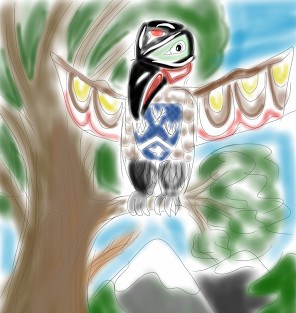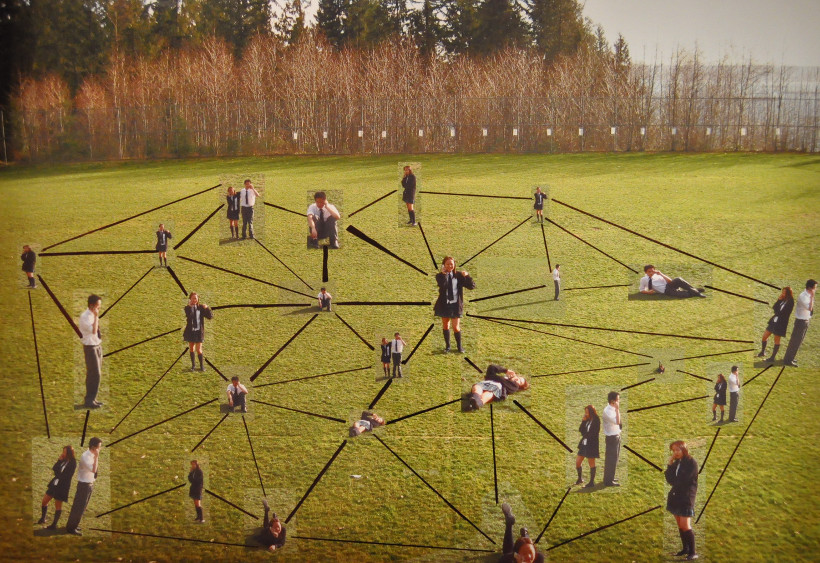Lines of Communication
Arts Education - Grade 8
This unit of inquiry is not a recipe book but rather a launchpad to inspire new BIG IDEAS. We encourage you to use and/or modify one, or several of the BIG IDEAS below. Adapt it to the grade/ ability level of your students.
Enduring Understandings
The arts provide opportunities for individual and collective expression.
Guiding Questions
How can line, the elements of art, be used to communicate and express ideas across boundaries: languages, experiences, locations, and age?
Mind Opening
Choose or devise practices to encourage students to be open to new experiences and ways of thinking in your classroom. For example, the MindUP in-school program.
Discovery and Inspiration:
Launch the Project
• Introduce the Theme: Present the Enduring Understanding and Guiding Questions using vocabulary that is appropriate for your grade level.
• About Vancouver Biennale: Play a short video.
• Create Project Space: Brainstorm ideas to make the project theme visual and visible using bulletin boards, and/or a project corner to share relevant materials and inquiry questions and processes.
Reference Resources:
• Introduction to Sculpture and Public Art Unit Plan for information on how art has evolved over time and the unique experience sculptures and/or public art brings
• Vancouver Biennale 2014-2016 Exhibition Theme: Open Borders / Crossroads Vancouver
• Vancouver Biennale Legacy Artwork: Echoes (Michel Goulet, Canada)
• About Artist and Artwork (PDF)
Learning to Learn:
Art Inquiry
Make a visit to Echoes and encourage students to freely interact with the art and explore the art piece at different angles individually and in groups. This Art Inquiry process enables the students to practice observing, describing, interpreting, and sharing visual information and personal experiences. Use the Art Inquiry Worksheet (PDF) to guide and capture their ideas and impressions. Customize or create your own Art Inquiry Worksheet as appropriate for your project and class needs.
BIG IDEAS Anywhere educators: View the Echoes Guided Tour Video MUTE ON and encourage students to explore at different angles individually and in groups.
Shared Insights
• Sharing Art Inquiry Experience: Ask students to share the Art Inquiry Worksheet responses in class.
• View Guided Tour Video: View the Echoes Guided Tour Video again with SOUND ON.
• Artist Themes – Research: In small groups students rotate between information stations detailing the artist’s life and work. Station topics include: (1) education and training; (2) lifetime of artwork; (2) materials and processes; (3) beliefs and values. At each station, students answer questions and complete a task. For example, at the station “life’s work” students might plot the artist’s various installations on a map of the world.
• Artist Themes – Element of Arts in Communication: How does Goulet’s work, Echoes use line to communicate? What relationship do you have to the environment and the people around you depending on which chair you sit in? Have students discuss in groups the use of lines in portraying meaning and the inter-relationship of environment and communication. How does the use of line cross borders of communication? How does culture or location impose meaning on line and form?
• Telephone Game: Sitting in a circle, a student starts by whispering a phrase into the next person which in turn passes whatever they heard as best they can to the next person. Each player can only say the statement once! When the message reaches the last person in the circle, he/she will say aloud what they heard. Compare that to the original message.
• Variation 2: Have the first player describe a drawn picture without saying what it is to the person next to them. The description will then get passed on. The last person will draw his/her version of the picture. Discuss how images/lines can be described in different ways and how a message can change meaning when it is passed from people to people.
• Variation 3 – Mimed version: Have students stand in a straight line facing a wall. The first player will tap the shoulder of the person in front of them so they turn around and then mime a word or phrase to them. Once the person watching thinks they understand what the word is, they nod their head, turn, tap the person in front of them and mime the message. Once the message gets to the end of the line, the last person will call out the word or phrase.
Have students look around and identify how lines are used in the classroom for communication (charts, drawings). Discuss the importance of strong lines of communication to convey a message.
Inquiry Challenges
• Visualizing Music: Use lines to communicate emotion with music. Have students sit with paper and a drawing tool. Play a piece of classical ‘visual’ music (Suggestions: The Moldau, Sabre Dance, Carnival of the Animals, Pictures at an Exhibition) and ask the students to empty their minds, not to consciously think or do anything and allow the music to flow through their tool and onto their paper. Look at and discuss the results from the mind opening exercise. Discuss thoughts/feelings during the exercise and any choices made depending on the quality of the music – repetition, loud vs. quiet, one instrument vs. many instruments, etc.
• Expressing Emotions: Have students experiment and draw different types of lines with specific emotions, for example, draw a ‘happy’ line, a sad line, etc. Experiment with different media/tools that best communicate the message. Swap papers with a classmate to interpret each other’s lines.
Have students discuss how line is used in communication. Explore ways lines have been used to communicate throughout human history without borders. Bring up samples such as the Nazca lines which are a series of ancient geoglyphs located in the Nazca Desert in southern Peru. Scholars differ in interpreting the purpose of these designs, but in general they ascribe religious significance to them. Common uses of lines in communicating messages are maps, charts and graphic designs.
Have students look at the artwork of artists of choice and note the different styles of line. Suggestions: van Gogh, Rembrandt, Schiele, Degas, Picasso, Kandinsky. Review a sampling of artworks and interpret different types of lines and discuss how they may relate to the message/mood the artist intended to communicate.
Student Creations and Taking Action
Have students investigate/explore creative ways lines are used in communication. Bearing in mind that various forms of signals can all be represented by lines. Present findings in graphic or spoken word format.
Following the discovery of line throughout many areas of life, have students discuss how strong lines of communication are important as members of a larger community. Reflect on existing communication issues within the classroom or in school, design a communication guide using lines and work on a communication plan to promote its distribution.
Reflection
• Teacher and students can reflect on their entire learning process by revisiting the Enduring Understanding and relevant Guiding Questions.
• How did the unit of study open inquiry, create cross–curricular learning opportunities and/or apply learning to real life situations? Has this unit of inquiry changed your opinions, values and world view? In what ways, if any, has it helped you grow as a learner?
Ideas for Cross-Curricular Access
• Language Arts – Reading visual texts and writing personal and imaginative texts: Have students write a short poem to describe the composition of lines and styles in the drawing using imaginative texts. Read the poem out loud in class and ask the class to visualize and sketch what the drawing looks like. Discuss similarities and differences in this interpretive process.
• Science – Cells and Systems: Have students discuss how signals are transmitted between cells in our body and the consequence of communication breakdown between certain cells. Draw analogy to the lack of communication within a family, team and across borders. Explore lines within a cell on a micro level using a microscope and scans
• Mathematics – Shape and Space: Have students create line drawings of top, front and side view of selected 3D objects. Visualize how these line drawings would take shape when the 3D objects are re-assembled from single dimension. Now construct the 3D objects.
• Social Studies – Society and Culture: Have students research and investigate how societies preserve identity and transmit culture. Compare findings of different civilizations. Discuss how people in the past used line to communicate messages across boundaries of time and space. Have students investigate civilizations of the past and their artwork, literature, writing systems/language, architecture, etc. Choose an artifact and discuss how lines are used to contribute to communicate a message. Discuss how society preserved its identity and transmitted its culture through these evidences of line.
• Economy and Technology, Environment: Have students explore maps and legends of past societies. Discuss how line is used to communicate distance, resources, population, patterns of settlement, routes of commerce and travel across borders. Compare with maps of today’s society
Credits
Written by: Nicola Twa, 2013 UBC Secondary School Teacher Candidate
Edited by: Jennifer Massoud, Secondary School Teacher
©2013 Vancouver Biennale
Related Material
 West Vancouver French Immersion Schools
West Vancouver French Immersion Schools